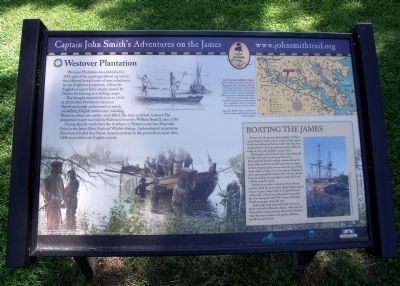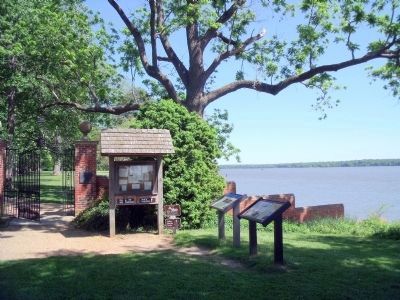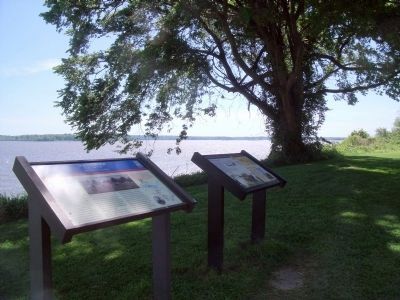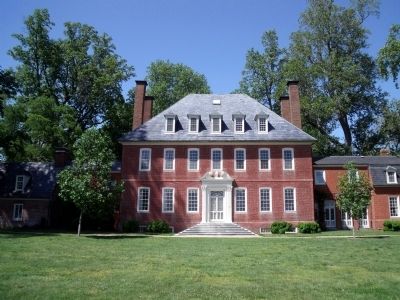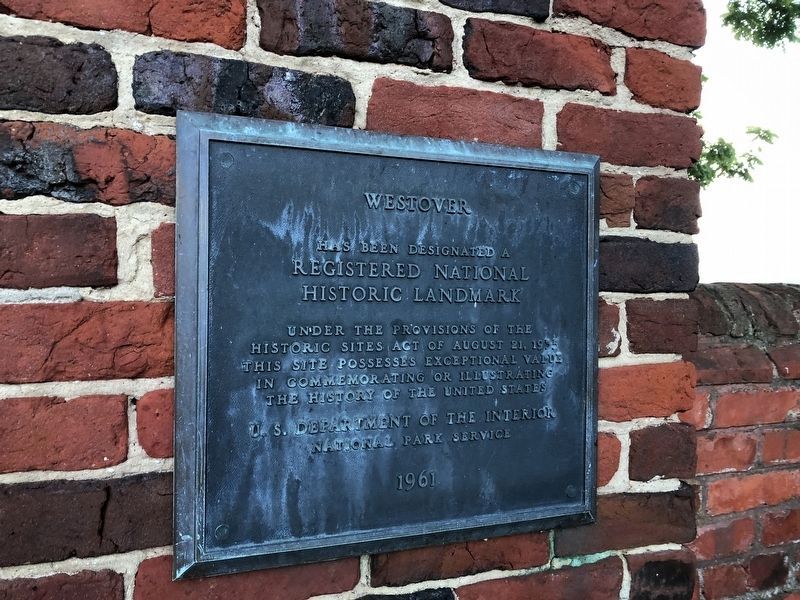Near Charles City in Charles City County, Virginia — The American South (Mid-Atlantic)
Westover Plantation
Captain John Smith’s Adventures on the James
— www.johnsmithtrail.org —
Westover Plantation was established in 1619, part of the rapid agricultural expansion that followed several years of mere subsistence for the English at Jamestown. Often, the English co-opted fields already cleared by Natives for farming or as fishing camps.
This brought strained relations to a boil in 1622, when Powhatan’s successor Opechancanough orchestrated an attack on outlying English settlements, including Westover, where two settlers were killed. The farm persisted, however. The plantation’s house was built by Richmond founder, William Byrd II, circa 1730.
Gazing directly south from the riverbank at Westover, one sees Maycocks Point in the James River National Wildlife Refuge. Archaeological excavations there have revealed that Native Americans lived on the promontory more than 1,000 years before the English arrived.
Capt. John Smith’s Trail
John Smith knew the James River by its Algonquian name: Powhatan, the same as the region’s paramount chief. Smith traveled the river many times between 1607 and 1609, trading with Virginia Indians to ensure survival at Jamestown. What he saw of Virginia’s verdant woodlands and pristine waters inspired him to explore the greater Chesapeake Bay, chronicling its natural wonders.
[Sidebar:]
Boating the James
Rivers were the primary thoroughfares of Algonquian Virginia. Indians made canoes of hard cypress wood, first hollowing the tree trunks with fire, then shaping them with stone tools and oyster shells. As many as forty men paddled a single canoe.
The English arrived aboard three large ships, the Godspeed, Susan Constant and Discovery. However, John Smith’s trading missions along the James River and his two 1608 exploratory voyages of the Chesapeake Bay were conducted on a smaller vessel called a shallop. It was brought to Virginia in pieces and assembled at Jamestown. At least 30 feet long, the shallop accommodated a crew of 15 and could be rowed or sailed.
During the past four centuries, boats of every sort have plied the James River. Early barges carried tobacco to port, where it left for England aboard sailing ships. Federal ironclad gunboats patrolled the river during the Civil War. Later, steamships ferried passengers across the river.
Today, large cargo ships still dock in ports in Richmond and in Hampton Roads, where the U.S. Navy retains a large presence. Recreational boaters enjoy the river in canoes and kayaks, sailboats, speedboats, and yachts.
Erected by Captain John Smith's Trail. (Marker Number 18.)
Topics and series. This historical marker is
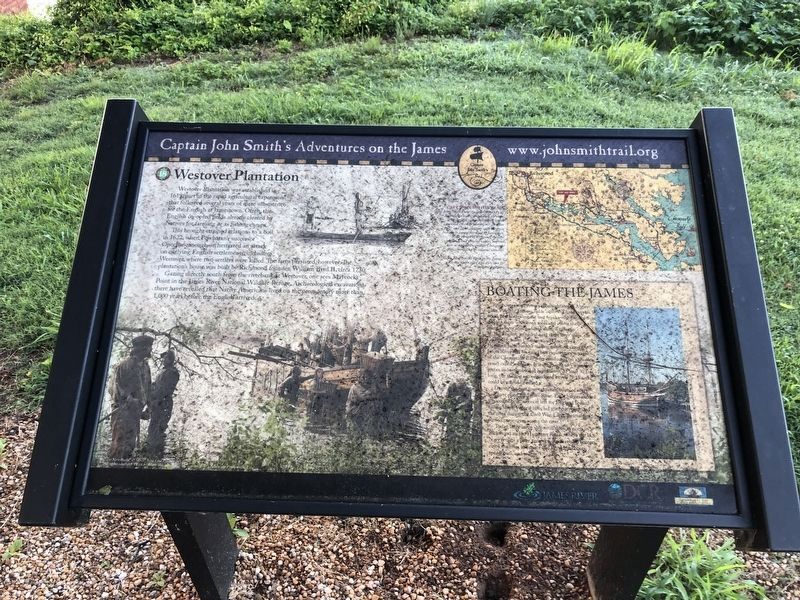
Photographed By Devry Becker Jones (CC0), June 26, 2021
2. Westover Plantation Marker
Unfortunately, the marker has weathered significantly.
Location. 37° 18.652′ N, 77° 9.067′ W. Marker is near Charles City, Virginia, in Charles City County. Marker can be reached from Westover Road (Virginia Route 633) 2.1 miles east of Harrison Landing Road. Touch for map. Marker is in this post office area: Charles City VA 23030, United States of America. Touch for directions.
Other nearby markers. At least 8 other markers are within 2 miles of this marker, measured as the crow flies. Westover (here, next to this marker); Richmond Condita (about 300 feet away, measured in a direct line); Benjamin Harrison (approx. 1½ miles away); Lane to Site of First Thanksgiving (approx. 1.6 miles away); Evelynton (approx. 1.6 miles away); Capt. John Woodliffe (approx. 1.6 miles away); Origin of Taps (approx. 1.6 miles away); Willie Johnston (approx. 1.6 miles away). Touch for a list and map of all markers in Charles City.
More about this marker. On the upper center is a sketch of an English shore party and an Indian canoe with the caption, “Drawing by Marc Caselli for John Smith Four Hundred Project ©2006.”
On the lower left is a depiction of the exploration of the James River by English colonist. The photo carries the caption, "“The New World” © MMV, New Line Productions, Inc. All rights reserved. Photo by Merie Wallace. Photo appears courtesy of New Line Productions, Inc."
On the upper right is a map Captain John Smith's Trail. The map carries the caption, "Capt. John Smith’s Trail on the James is a 40-site water trail and auto tour for modern explorers."
On the sidebar is a photo of “A replica of the Susan Constant at Jamestown Settlement.”
Also see . . . Capt. John Smith's Trail. (Submitted on April 29, 2010, by Bernard Fisher of Richmond, Virginia.)
Credits. This page was last revised on July 14, 2022. It was originally submitted on April 29, 2010, by Bernard Fisher of Richmond, Virginia. This page has been viewed 2,105 times since then and 95 times this year. Photos: 1. submitted on April 29, 2010, by Bernard Fisher of Richmond, Virginia. 2. submitted on June 26, 2021, by Devry Becker Jones of Washington, District of Columbia. 3, 4, 5. submitted on April 29, 2010, by Bernard Fisher of Richmond, Virginia. 6. submitted on June 26, 2021, by Devry Becker Jones of Washington, District of Columbia.
